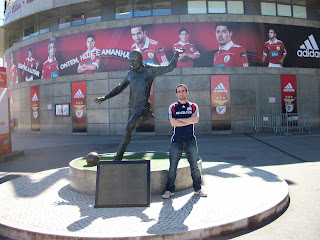Following the club, we joined the regulars for a trip to Mactorcaills to celebrate Russell's birthday. En route, Sean and I helped a stranded motorist push-start his car on Pearse street, as city buses and passing cars threatened to sideswipe the guy holding the wheel. Such a deed was absent in our subsequent trip to Mactorcaills on Friday, following the jazz band at the Pav earlier that night.
On Saturday morning, the regulars set out for Phoenix Park, the largest urban park in Europe. Unfortunately, the blue skies and sunny, warm weather that marked the weekdays before was absent that morning. Nevertheless, we walked the 50 or so minute trip along the North Side of the Liffey to the park's entrance. While there, we visited the tree, under which Brittany regained her hearing, and scaled the massive Duke of Wellington Monument - well more of a miniature Washington Monument. Eating lunch on the granite was not quite the lying-in-the-sun park day that we had imagined, but Brittany and Maggie persuaded us to do a few cartwheels on the grass below.
 |
| Atop the Wellington Monument |
Instead of visiting the Gaol's extensive, 3-floor museum - and presumably similar artifacts as Wicklow - we left for the next-door Irish Museum of Modern Art, as housed in the 17th Century Royal Hospital of Kilmainham. Behind the castle-styled gatehouse to the Museum's grounds was a wide tree-lined avenue to the building's front door. As was expected, closer to the building were various forms of artwork, a interesting juxtaposition given the graveyards that neighbored the gatehouse.
After crossing into a courtyard that mimicked Collin's Baracks, we entered the free Museum. Inside two temporary exhibitions received our full attention. The first was a stirring collection of photographs from the 1970s, which depicted the Troubles in Northern Ireland. The second was a series of paintings by one artist who enjoyed to depict a detailed background covered by an unrelated and different media foreground of intertwining geometric designs. Each canvas was covered in brilliant colors and contrasted well with the white walls of the exhibit. Before seeing the entire permanent exhibit, we were distracted by the response room, where we joined others our age, to draw away the minutes before our tour at the Gaol.
For the tour, we joined at least twenty or so others in a walk through the building's original wing (built in 1796), the death row cell, the movie-famous East Wing, and the work and execution yard. Our guide mixed comedy with history and held our attention for the hour-long visit. Of note were the cells that held the leaders of the 1798 rebellion and the 1916 Easter uprising. In regards to the latter, the swift executions of leaders of that movement is credited with spurring the 1919 successful revolution. In addition, many who opposed the free state during the civil war were interned in the Gaol, including the future Taoiseach and later President Eamon de Valera. For its history and presentation, the facility is well worth a visit.
 |
| By the Irish sign for the Gaol |
On Sunday, daylight savings time finally reached Ireland, but not our Nokia phones. So nearly everyone failed to wake up on time for our departure to Dun Laoghaire, a coastal town on the Dart line south of Dublin. Adding fears regarding papers and upset stomachs, only Sean and I managed to keep the trip.
The town is far more developed than it's coastal cousin to the North. After walking along the seawall that enclosed a harbor boasting four yacht clubs, we continued around the town, nearly in vain, to find the Sunday market. Fortunately, we located the bustling stalls and vendors in a park further from the Dart Station than we had expected. Inside we purchased huge Italian sausages and set out for the "Joyce" tower - more likely an ordinary Martello tower than a temporary home of the famous author.
After reaching the closed tower Museum, we explored the Forty Foot "beach" nearby. Despite an abundance of jagged rocks, this section was ensconced by a worn variety of sea walls and beach stations. At its furtherst point, more than several individuals defied the rocky coasts and plunged into the water below. Given the name and their survival, the jumping spot must have some depth.
 |
| Christ the King statue in Dun Laoghaire |
On the way back from the beach, we stopped at Teddy's Ice Cream shop along the shore. A line extending down the street attested to its price (1.60 euro for a large cone) and quality. We waited in line, and devoured our vanilla cones, complete with a chocolate stick, before taking the Dart back to Dublin.
Next weekend we hope to catch Dublin v. Kilkenny at Croke Park in Hurling and Gaelic Football. During the week I will write my final Politics paper, as we have but two weeks of classes before pre-finals break.








